|
In 1984, Harrington & Richardson Firearms
got together with the Federal Cartridge Company and
introduced a dandy little revolver cartridge called the .32
H&R Magnum. They lengthened the .32 S&W Long cartridge
and loaded it to higher pressures to give a lot more power to
the little .32 revolver. The factory load was advertised to
propel an eighty-five grain jacketed hollowpoint bullet to
around 1100 feet-per-second (fps). There was also a ninety-five
grain lead bullet load at an advertised 1030 fps. This new
ammo was a significant improvement over the shorter .32 S&W
and .32 S&W Long cartridges, and the new H&R revolvers
could also fire the other two cartridges in addition to the .32
H&R Magnum. While never loaded to true magnum pressures like
the .357, .41, and .44 Magnum cartridges, the little .32 Magnum
was a step in the right direction.
About three weeks ago, Federal and Ruger
introduced a new .32 caliber cartridge that promises to be all
that the .32 H&R should have been, had it been loaded to
magnum pressures. The problem was with the early H&R
revolvers. They just would not take real magnum pressures, so
the .32 H&R Magnum cartridge, while still a relatively hot
.32, was never loaded to its potential. Ruger jumped on board
with the .32 H&R cartridge back in 1985, and handloaders
have been hot-rodding the .32 H&R in Ruger revolvers ever
since, loading the cartridge to its potential using powders like
Hodgdon’s Lil’Gun,
WW296 and H110, among others.
To keep the new .327 Federal Magnum out of the
weaker H&R and other lightweight revolvers, and to increase
its powder capacity slightly, Federal lengthened the .32 H&R
case by .125 inch, for a .327 Federal Magnum case length of 1.20
inches. The first handgun on the market chambered for the
.327 Federal Magnum is the tough, reliable little Ruger SP101.
The little SP101, as stated above, has been chambered for the
.32 H&R cartridge for over twenty years. It is also
chambered for the .357 Magnum cartridge in a five-shot version,
but the .327 Federal Magnum version still uses the six-shot
cylinder of the .32 H&R SP101. Ruger and Federal are
marketing the new gun/cartridge combo towards the self defense
handgun buyer at this time, but I see plenty of potential for
this new cartridge as a hunting round as well.
Immediately after the new cartridge was
announced, the shooting forums were filled with shooters, and
some who pretend to be shooters, denouncing the new cartridge as
everything from being too loud to it being almost useless; all
this from people who had never seen the gun nor the cartridge,
much less having ever fired one. Some of us, including myself,
were almost ecstatic hearing the news of the little .327 Federal
Magnum. Those whom I know personally, like my friends Terry
Murbach, Al Anderson, and Fermin Garza, who
got excited about the new cartridge are actually shooters. These
men shoot more ammunition in one year than most shooters will
ever see in their lifetimes. All three of these gentlemen, while
owning and shooting many big bore revolvers, are also great fans
of the little .32 H&R cartridge, and immediately recognized
the potential for the new .327 Federal Magnum. These three
friends are scattered geographically around the United States,
but we all know each other through our love of firearms, and our
inclusion in that brotherhood known as "The
Shootists". I mentioned these men here because they
are true experts on guns, and revolvers in particular, but also
would consider themselves as students of firearms, always
willing to learn and experience new advancements in cartridge
design. I contrast this with the pseudo experts who sit readily
by their respective keyboards anxiously awaiting the opportunity
to knock any new gun or cartridge that is introduced.
Having stated the above, the question is bound
to be asked; "What is the .327 Federal Magnum good
for?" That is always a fair question, even if it is
grammatically incorrect. The simple answer is that it can do
anything and everything that the .32 H&R cartridge can do,
but do it better. It has more pressure and more case capacity,
resulting in more bullet speed. Lots more bullet speed. More
velocity makes it hit harder and penetrate deeper, with the
right bullet. The .327 Federal Magnum will probably supplant the
.32 H&R in every area except for the game of Cowboy
Action Shooting, where light bullets and low velocities
are preferred. However, Cowboy Action Shooting is only a game.
The .327 Federal Magnum is made for more serious applications.
It offers more power than the .32 H&R, with less recoil and
muzzle blast than the .357 Magnum. In the SP101, you get six
shots of .327 Federal as opposed to five shots of .357 magnum,
but the main attraction, for defensive purposes, is that the
.327 promises true magnum penetration without the recoil of the
larger magnums.
Some "experts" claim that the new
cartridge is not needed, as we already have the .30 Carbine and
.32 WCF (.32-20) cartridges. First, the .30 carbine is a good
cartridge, but it has no rim, is slightly tapered, and would
require moon clips for reliable, quick extraction in a double
action revolver. While the case capacity of the new .327
Federal Magnum and the .32-20 are close to the same, loading the
.32-20 to the higher pressures required to achieve the
velocities desired from a three inch barrel would destroy many
of the old guns that are chambered for the cartridge. The .32-20
is also tapered, being primarily a rifle cartridge. Lengthening
the .32 H&R into the brand new .327 Federal Magnum was the
logical choice.
For a defensive handgun, I always lean towards
penetration. I am asked everyday to recommend a defensive
cartridge to those who are needing a handgun for protection. If
a person can easily handle a small .357 magnum revolver, that is
a good choice. However, the question of recoil often enters into
the choice of cartridge. While in a service sized revolver the
.357 is easily controlled, in a smaller package it can be a
handful. Many times, I recommend a .22 Magnum for those who, for
whatever reason, cannot handle or desire a hard-kicking gun. The
.22 Magnum penetrates well, and getting the bullet to the vitals
as deeply as possible damages more nerves, organs, and blood
vessels. A bullet that does not penetrate does not tear up as
much flesh. The new .327 Federal Magnum promises penetration,
with less recoil than the .357 Magnum. That, along with good
bullet design, should make for a dandy little defensive gun.
Regarding the Ruger SP101 revolver, it is
probably the toughest, most reliable compact double action
revolver on the planet. Weighing 28 ounces with a three and
one-sixteenth inch barrel, the SP101can easily handle a steady
diet of the high pressure .327 Federal Magnum. The weight is
heavy enough to help tame the recoil, but light enough to carry
easily and comfortably in a belt holster. I regard the SP101 as
being a bit heavy for everyday carry in my pants pocket, but for
wintertime carry in a coat pocket, or in a compact
inside-the-pants holster, it rides easily. Made primarily of
stainless steel, the SP101 is highly resistant to corrosion from
sweat and damp weather, as any carry gun should be. The
synthetic rubber grip is an excellent design, combining a
compact size with a comfortable hold. Even in the .357 Magnum
version of the SP101, the grip design is very comfortable to
shoot. The barrel is of a heavy profile, and also aids in
accurate rapid fire. The sights are pretty easy to see for a
compact defensive weapon, and the rear is adjustable for windage
correction. The trigger pull on the sample gun measured a smooth
nine pounds, six ounces in double action mode, and a crisp
three and three-quarters pounds in single action mode. The
sample SP101 has a very good trigger action. The barrel/cylinder
gap measures five one-thousandths (.005) of an inch. The
cylinder bolt notches are offset, and not directly over the
chambers, making for a stronger design.
Federal is offering three factory loads for the
.327 Federal Magnum at this time; a Federal Premium 85 grain
Hydra-Shok hollowpoint at 1330 fps, a Speer Gold Dot 115 grain
hollowpoint at 1300 fps, and an American Eagle 100 grain
jacketed soft point at 1400 fps. These velocities are advertised
as being fired from the 3 1/16 inch barrel of the SP101. I only
had the American Eagle load for testing. It chronographed at an
average velocity of 1374.9 fps at eight feet from the muzzle, so
corrected to muzzle velocity, the Federal specifications are
dead on accurate.
With all of the negative comments early on from
folks who have never fired the cartridge, there was a few things
that I particularly wanted to test; those being muzzle blast,
recoil, and penetration. I compared the muzzle blast of the .327
Federal Magnum to the .357 Magnum fired from guns with equal
length barrels. I used for this test two Ruger SP101 revolvers,
identical except for the cartridge. Holding the decibel meter
beside the shooter’s head, the readings seem close, with the
.327 registering 120db and the .357 reading 124db. However,
decibel readings are logarithmic instead of linear, and 124db is
noticeably louder than a reading of 120db. The .327 Federal
Magnum does indeed have less muzzle blast than does the .357
Magnum, at least using factory loads with the same bullets
weights.
Measuring recoil was more subjective, meaning I
did not have any instrument to measure the recoil. However,
recoil has to abide by the laws of physics, and can be
calculated. Both guns having equal barrel lengths and almost
identical weights, the .357 Magnum has more recoil using equal
bullet weights because it will fire a 100 grain bullet about 200
fps faster than the .327 Federal Magnum. The difference in
felt recoil to the hand is also noticeable. The fly in this
ointment is that the .357 Magnum is hardly ever used with the
light-for-caliber 100 grain bullet. To get better penetration,
most shooters use at least a 125 grain bullet in the .357
Magnum, and recoil with that bullet is heavier than the recoil
of the .327 Federal Magnum using the 100 grain bullet by a
considerable margin. Keep in mind here that in all these tests,
I am using factory ammunition. I will get into the handloading
portion a bit later. To keep things fair and in perspective,
only factory loads were used in the recoil and muzzle blast
tests.
Next I moved on to testing the .327 Federal
Magnum for penetration. As mentioned early on, I am a believer
in penetration above all else when it comes to a cartridge that
will be used against flesh. The .327 Federal Magnum is marketed
as a defensive revolver, so it had to be tested in flesh. Since
shooting live humans is illegal, immoral, and distasteful, and
fresh cadavers are hard to come by out in the woods, I rode into
town and bought a whole pork shoulder from the local butcher. I
told him that I wanted the biggest one that he had. It weighed
just over twenty-three pounds. Again, I used only the Federal
factory American Eagle 100 grain load for this test. I had three
reasons for this: I wanted to use a load that is available
to anyone who buys one of these revolvers, most people
will carry their defensive handgun loaded with factory
ammunition, and meat is expensive. Taking aim from a
distance of ten feet and aiming just inside the shoulder blade,
I fired into the pork shoulder from the end. The American Eagle
jacketed softpoint bullet fully penetrated the shoulder. I had
hoped to be able to stop the bullet and see just far it would
penetrate the meat, but sixteen inches was the entire length of
the shoulder. The entrance and exit holes were very
similar, with some cratering around the entrance. Opening up the
shoulder, about seven inches in showed a large amount of
cavitation and tissue damage. Seven inches is about optimum for
this. Measure into your chest about seven inches and you will
see that there is a lot of important stuff in that area. This
damage started near the entrance, peaked at about seven inches,
and then tapered into a channel of about one-half inch diameter
through to the exit. I am very pleased at the performance of the
penetration test.
Handloading for the new .327 Federal Magnum
presented a slight challenge, as there is yet no load data
available. I used a set of Lee carbide .32 H&R
loading dies, and crimped separately from the seating operation.
The dies worked perfectly for all bullet weights tried, and all
loading was done on a Dillon 550B
machine. I based my powder choices upon what I have learned from
loading the .32 H&R Magnum to higher than factory pressures,
taking advantage of the .327’s greater case capacity. My
powders of choice were H110, Lil’Gun, Accurate Arms
Number 9, H4227, Accurate 1680, and Winchester 571. I
found H110, AA # 9, and to a limited extent Lil’Gun to work
best in this particular revolver. With H4227 and AA1680, I could
not achieve velocities equal to the factory load with a 100
grain bullet, so I gave up on those. I tried no light target
loads in the .327, as we have the .32 S&W Long and the .32
H&R Magnum for target and mid-range loads, respectively. The
.327 Federal Magnum is a true magnum, and that is the area
in which I concentrated my efforts. Using Winchester 571 was a
mistake. It is an excellent powder, but not at all suited for my
purposes here. I screwed up, and found out that the Ruger SP101
is even a lot stronger than I had previously believed. Brass
flows at 75,000 psi, and I exceeded that. I would have badly
wrecked a lesser gun. The best powders for the .327
Federal Magnum proved to be H110 and AA # 9 for most all bullet
weights, with Lil’Gun performing very well with the heavier
bullets. I tested many different combinations using 60, 85, and
100 grain Hornady XTP hollowpoints, 113 grain cast lead
gas check bullets from Cast
Performance, 120 grain cast lead gas check bullets from Mt.
Baldy Bullet Company, and a 135 grain cast lead bullet
that was hand-cast by my friend John Killebrew.
John designed this bullet with the help of Jimmy Pilcher,
and it is a dandy bullet for loading the .32 H&R, .32-20,
and now the .327 Federal Magnum cartridges. I was able to safely
achieve velocities equaling the 100 grain factory load using AA
# 9 and H110. AA # 9 also proved to be the powder of choice for
the 60 and 85 grain XTP hollowpoint bullets. The little 60 grain
XTP screamed out of the little Ruger at over 1740 fps. Moving to
the lead bullets, AA # 9, H110, and Lil’Gun did very well. One
thing that I really like about lead bullets is that they give
greater velocity, as compared to jacketed bullets, with equal
pressures. In the Ruger SP101, with its long cylinder, I was
able to seat the 135 grain Killebrew bullets out longer than
usual, crimping in the top lube groove instead of the crimp
groove, taking advantage of the case capacity of the .327
Federal Magnum. I was able to push the 135 grain cast lead
bullet to over 1250 fps with Lil’Gun. I achieved significantly
higher velocities than that, but extraction became a bit sticky
over 1300 fps, so I backed off. I used CCI magnum small
pistol primers in all loads tested, but I am deliberately not
listing powder charges, as none of this data has been pressure
tested. By the time guns and ammunition hit the dealer’s
shelves by January 2008, pressure tested load data from
reputable sources should be available. I will add that
handloaders can safely reach factory velocities with jacketed
bullets, and exceed them with lead bullets. Later, I will get
into another article dealing with handloading the .327 Federal
Magnum for hunting, but as for right now, the Ruger SP101 is a
dandy little defensive revolver, but its barrel length precludes
it from being a legal hunting arm in most states.
For accuracy testing of the .327 SP101, I
enlisted the help of my Ransom
Master Rest, to eliminate as much human error as
possible. I was pleasantly surprised at the accuracy of the
little Ruger, with it being a brand new high pressure handgun
cartridge. All ammo tested grouped into less than two and
one-half inches, with both the best and worst groups fired shown
in the pictures. Even the largest group at just over two inches
is excellent accuracy, good enough for small game hunting, and
more than enough accuracy for defense. While it is not
absolutely necessary for a fighting handgun to display target
grade accuracy, it is always nice when it does.
Over the course of the last three weeks, I have
really given this SP101 a workout. I have loaded and fired
the weapon hundreds of times, and never cleaned it. It is
filthy, but it never misses a beat. Case life has been
very good, despite my abuses. I began with one hundred factory
cartridges, and used the first fifty of those that I emptied for
all of the handloading. I only lost one case, and that was due
to my negligence. All of the others have held up perfectly, and
the primer pockets are still tight.
I carried the little Ruger around concealed in
the very versatile Simply Rugged Pancake holster. This
holster has detachable belt loops that allow it to be used as an
inside-the-pants holster, and has slots to allow either strong
side or crossdraw carry on the belt. Rob Leahy at Simply
Rugged makes some fine holsters at very reasonable prices. As I
have in the past, I highly recommend his work.
The little SP101 is a pleasure to shoot. The
design of the synthetic rubber grip is hand filling, but
compact. Recoil is very manageable, somewhat like a .38 Special,
and muzzle blast is not bothersome. Penetration exceeded my
expectations with the one factory load that I had available. I
would suspect that the other two factory loads using the high
performance hollowpoint bullets would penetrate less, and they
just might be ideal for self defense. I won’t know for sure
until I try them.
If you can’t tell already, I really like the
new .327 Federal Magnum. It is everything that the older .32
H&R should have been. It operates at true magnum pressures
to deliver true magnum performance. It has a good home in the
Ruger SP101, but I also see a future for the cartridge in other
handguns, and maybe even a carbine. As I type this, I know of at
least one custom gunsmith that is making up a couple of single
action revolvers for the .327 Federal Magnum. In the SP101, the
.327 offers a good package for a self defense weapon, especially
for those who want an effective weapon with good penetration and
less recoil than the .357 Magnum, along with one more cartridge
in the same sized handgun. A lot of shooters opt for a
semi-auto defensive pistol, but for many, the rugged reliability
and simplicity of a good revolver has its advantages., and it
doesn’t leave empty brass laying around on the ground.
In the world of rugged and reliable compact medium bore double
action revolvers, the SP101 is king, and I will not hesitate to
recommend the .327 SP101 to those needing an accurate defensive
piece. It is a very versatile weapon, firing the .32 S&W,
.32 S&W Long, and the .32 H&R cartridges in addition to
the .327 Federal Magnum cartridge.
Check out the full line of Ruger products
here.
For the location of a Ruger dealer near you,
click on the DEALER FINDER button at www.lipseys.com.
For more information on the Federal, Speer, and
American Eagle line of cartridges, go to www.federalcartridge.com.
To order the bullets tested here, go to www.castperformance.com,
www.mtbaldybullets.com,
and www.hornady.com.
To order one of Rob Leahy’s Simply Rugged
Pancake holsters, go to www.simplyrugged.com.
Jeff Quinn
|
For a list of dealers where you can
buy this gun, go to: |
|

|

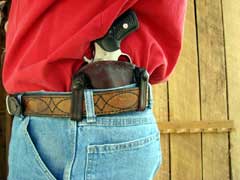
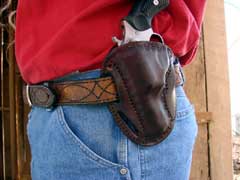
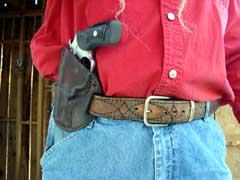
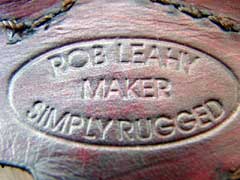
Simply Rugged's Pancake holster is an
excellent choice for the SP101. The versatile design allows the
gun to be carried inside the waistband, strong-side or
crossdraw.
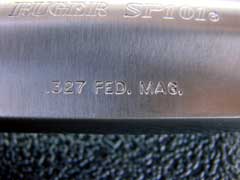
The .327 federal Magnum is a little round
that's BIG on performance!
  
Got something to say about this article? Want to agree (or
disagree) with it? Click the following link to go to the GUNBlast Feedback Page.
|
Click pictures for a larger version.
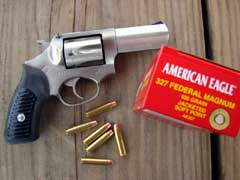
Ruger's SP101 in .327 Federal Magnum.

Gun comes with a hard plastic case.
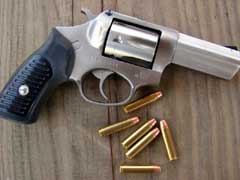
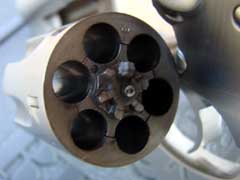
Although the .357 Magnum SP101 utilizes a five-shot
cylinder, the .327 Federal Magnum version features a six-shot
cylinder.
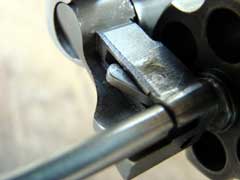
Crane locks into the frame, giving the SP101 a rugged
lockup at front & back of cylinder.
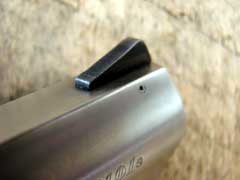

Front sight (top) is interchangeable to allow for
elevation adjustment, while the rear blade (bottom) is
screw-adjustable for windage.


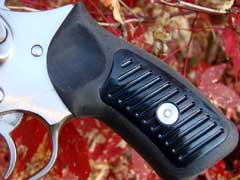
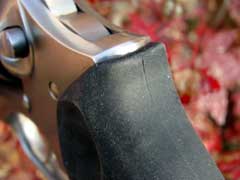
Grips are soft rubber with grooved hard plastic inserts,
and are excellently-designed for most shooters.
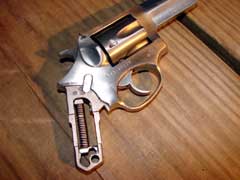
The SP101's grip stud design allows for a wide variety
of custom grips.
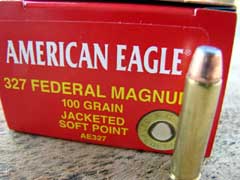
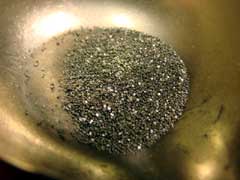
Factory ammo uses a fine-grained flattened ball powder.
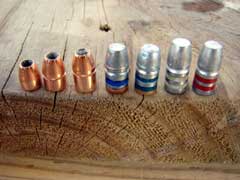
Bullets tested (left to right): Hornady 60-grain XTP
hollowpoint, Hornady 85-grain XTP hollowpoint, Hornady
100-grain XTP hollowpoint, Cast Performance 113-grain lead
gas-check, Mt. Baldy 120-grain lead gas-check, John Killibrew
135-grain lead plain-base with soft lube, John Killibrew
135-grain lead plain-base with hard lube.
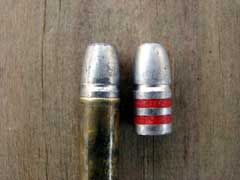
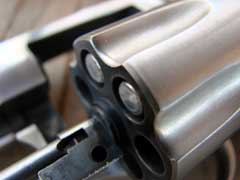
The SP101's cylinder is long enough to accommodate the
heavy John Killibrew 135-grain bullet, even when crimped into
the front grease groove.
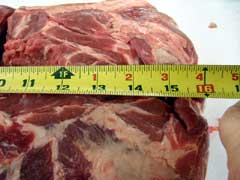
American Eagle's 100-grain factory load fully penetrated
16 inches of fresh pork shoulder.
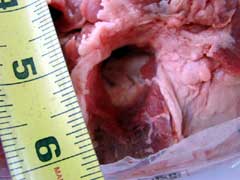
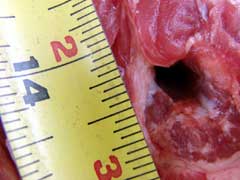
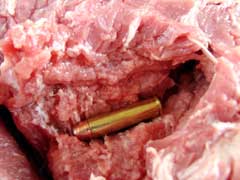
Entrance wound (top), exit wound (center) and wound
channel 7" inside entrance (bottom) show the excellent
performance of the .327 Federal from the 3-1/16" barrel
of the SP101.
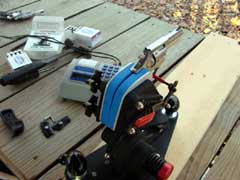
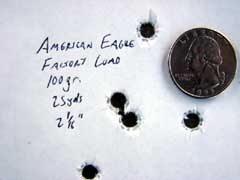
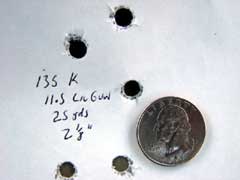
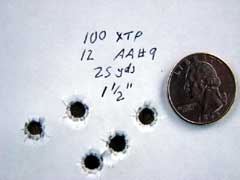
Accuracy testing from the Ransom Rest at 25 yards showed
the SP101 to be quite accurate.
|
![]()